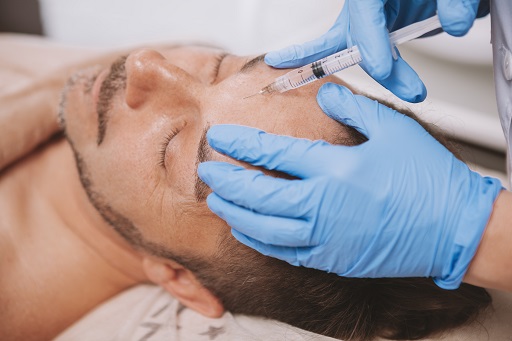
Botox for men is a popular anti-wrinkle treatment that involves the injection of botulinum toxin into specific areas of the face or neck. Botox works by limiting muscle contractions. Careful Botox injections help to prevent the formation of new lines and reduce the potential for existing lines and wrinkles to become deeper and more noticeable.
Non-surgical aesthetic treatments, such as Botox, have been embraced by women around the world for decades. But, over the past ten years, more and more men have begun to desire treatments to help them look more youthful and fresher and feel better about themselves throughout the ageing process. Botox has been the most commonly used injectable anti-ageing treatment for women since it was approved by the FDA in 2002. Now, Botox for men is fast becoming just as popular and is one of our most requested aesthetic treatments for men at our London clinic in Harley Street.
In this post, we will answer some of the most common questions about Botox for men, anti-ageing treatment, and dispel some of the main myths around this incredibly effective injectable treatment.
Botox for men is fundamentally the same treatment as for women. Botox is made from purified Botulinum toxin, the same toxin that causes food poisoning. However, when using Botox, the amounts are so tiny it does not make you ill, and when injected, it works by inhibiting muscle contractions. This limits muscle movement, reducing the formation of new lines and deepening pre existing ones.
But the key difference between Botox for men and Botox for women is that generally, men tend to desire more subtle results. An experienced aesthetic practitioner will adapt their technique, the areas, and the concentration of Botox for the anatomy of the male face and to meet the desired results of the individual.
Botox treatment can be adjusted by using lower concentrations and different injection techniques to satisfy the desires of the individual. Generally, men want to retain some facial movement and do not desire total eradication of existing lines and wrinkles. Retaining facial movement following Botox for men, anti-wrinkle treatment is possible by strategically injecting specific areas multiple times with small volumes of a low concentration of Botox.
The four key issues that Botox for men treatment looks to address are:
Men often fear that having Botox treatment will leave them looking “frozen,” making it clear that they have undergone this anti-ageing procedure. It’s critical to choose an aesthetic practitioner who offers Botox for men and takes the time to discuss the results you desire to ensure some muscle movement remains to prevent the “frozen” face often associated with Botox treatments.
People close to you may notice that you appear well-rested and look fresher following Botox treatments. But people who do not know you should not be able to tell you have had Botox when it is injected strategically by an experienced practitioner.
The results of Botox will become noticeable within 24 to 72 hours. The length of time Botox lasts depends greatly on the volume and concentration injected. Botox for men tends to use lower concentrations in smaller amounts — using a higher number of injection points. Also referred to as baby Botox or preventative Botox, when this technique is used for younger men and women, the results tend to last between three and four months.
Other key factors that impact the time Botox treatment lasts are lifestyle and individual physiology. Botox can last as long as six to nine months in some individuals. It’s also important to note that following consecutive Botox treatments, even when the Botox wears off, it will take time for muscle movement to return, as muscles will become weaker over time due to lack of use. Consequently, you may be able to leave a slightly longer gap between treatments before sufficient movement is recovered, which can cause lines or wrinkles to appear.
Botox is considered a safe anti-ageing injectable treatment that has few side effects. When they do occur, they are only temporary, generally wearing off within 72 hours. Expected side effects around the injection points include minimal:
Severe Botox side effects associated with incorrect injection techniques or unlicensed products may not completely resolve for several months and include:
Botulinum toxin type A, which is used to make Botox, is incredibly dangerous and even life-threatening in large enough concentrations. However, the concentrations of botulinum toxin type A required to create Botox are so small they are not considered dangerous.
Additionally, Botox has an exceptional safety record. A 2005 study on Botox injections for therapeutic and cosmetic cases found that between 1989 and 2003, the FDA received reports on just 36 serious side effects related to Botox treatments in cosmetic cases. Of these, 13 patients who had adverse effects also had underlying medical issues that could have contributed to these reactions.
However, Botulism poisoning is a risk when unlicensed anti-wrinkle products are injected. When compared to Botox, Dysport, or Xeomin, these unlicensed medications may also contain significantly larger doses of botulinum toxin type A and are not intended for use in humans. These products can be bought online and are more likely to be found in the hands of “aesthetic practitioners” with little to no training, who come to administer Botox at parties in hotels and at people’s homes.
Not only does this increase the risk of infection due to a less than hygienic environment, but inexperienced and poorly trained practitioners can inject the incorrect muscle or too deeply, which could result in issues like arched or crooked eyebrows, drooping eyelids (Ptosis) or an uneven smile. For this reason, it is extremely important to only receive Botox from a reputable aesthetic practitioner at a registered clinic.
Extensive research into the adverse effects of Botox has shown that its long-term use for cosmetic purposes does not cause cumulative adverse effects. Additionally, no research demonstrates that the thinning of skin is an adverse effect of the long-term use of cosmetic Botox.
However, Botox is known to have the potential to cause muscle atrophy (loss of muscle tissue). But, as this condition also occurs during the natural ageing process, it’s hard to ascertain if this is an adverse effect of Botox injections.
Research into blindness following incorrectly injected dermal fillers may be caused by vascular occlusion. However, no research supports any evidence that Botox can cause blindness. Furthermore, instances of post-injection blindness worldwide, reported in a thorough meta-review over 20 years, found no evidence linking Botox to any single complication of blindness associated with a cosmetic injection.
Because the risk of complications following Botox injections is low and it’s just an injection, it may appear easy to administer. This has led to a rise in people who have no medical background or qualifications taking one-day courses and setting themselves up as aesthetic practitioners offering Botox treatments. But, complications are more likely when Botox is performed by someone who does not have an in-depth understanding of the facial nerves and neurovascular structures.
Choosing an experienced, medically qualified, and registered practitioner working in an aesthetic clinic is the best way to reduce the risks of Botox and potential side effects. Currently, in the UK, anyone can inject Botox (and dermal fillers) without medical training. Many practitioners will only attend a one-day course if they choose to attend any type of training at all. Always check that the practitioner is a registered doctor, dentist, or nurse and has attended in-depth training supported by accredited medical bodies.
Dr Chia Tan is the founder of Harley Street MD in London, a CQC-registered clinic. Recognised as one of the most renowned aesthetic doctors in the UK, Dr Tan is a trained doctor registered with the General Medical Council (GMC) and holds a Diploma in Otolaryngology-Head and Neck Surgery (DOHNS). In addition to this surgical training, he is also a member of the Royal College of Surgeons (RCS) and the British College of Aesthetic Medicine (BCAM).







